Dive Bombers
Vultee A-31/A-35 Vengeance
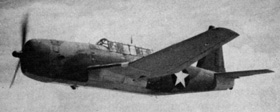
Designed under the designation V-72, the aircraft that would eventually be named Vengeance by the British was developed as a dive bomber by the Vultee Corporation. One of few U.S. military aircraft who's initial development was not aided by government finance, the V-72 was intended for sale to export markets. Large numbers (for the time) were sold to Brazil, China, Turkey, and the USSR during the mid-to-late 1930s. In 1940 the British purchased 700 V-72s (400 of which were manufactured by Northrop), and with the introduction of lend-lease in 1941, the U.S. ordered 300 more examples for the British under the designation A-31. The majority of British Vengeances served in Burma, where they enjoyed considerable success. When the U.S. entered the war, it commandeered 243 of the aircraft meant for Britain, and later had even more Vengeances manufactured for the USAAF under the designation A-35.
Type: two-seat dive bomber
Crew: 2
Armament: six 0.50 cal machine guns
up to 2,000 lbs. of bombs
Specifications:
Length: 39' 9" (12.12 m)
Height: 15' 4" (4.67 m)
Wingspan: 48' 0" (14.63 m)
Wing area: 332 sq. ft (30.84 sq. m)
Empty Weight: 10,300 lb (4672 kg)
Max Weight: 16,400 lb (7439 kg) max at takeoff
Propulsion:
No. of Engines: 1
Powerplant: Wright R-2600-13 Cyclone 14 radial
Horsepower: 1700 hp
Performance:
Range: 2300 miles (3701 km)
Cruise Speed: 230 mph ( 370 km/h)
Max Speed: 279 mph ( 449 km/h) at 13,500 ft
Ceiling: 22,300 ft (6800 m)
Douglas BTD Destroyer
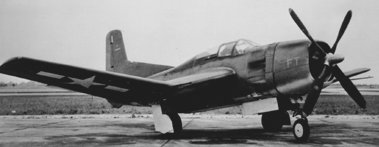
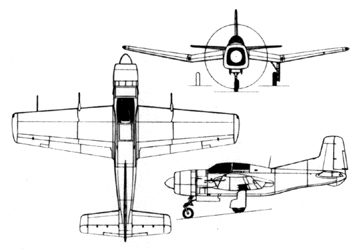
The war in the Pacific showed the success of the Douglas Dauntless dive bomber. The U.S. Navy was looking ahead for a replacement, leading to the development of an advanced two-seat dive bomber called the Destroyer that took its first flight in 1943. It was the first U.S. Navy carrier aircraft to have tricycle landing gear. It was soon modified for the new role of a single-seat torpedo/dive-bomber, with a 1943 contract increasing orders to 358 examples. Deliveries of production aircraft began in June 1944, but only 28 had been delivered before contract cancellation was initiated on VJ-Day. The Destroyer's performance was disappointing and, so far as is known, the type was not used operationally.
Type: torpedo/dive-bomber
Crew: 1
Armament: two 20mm cannon in wings
one torpedo or
up to 3200 lbs. of bombs in internal bay
Specifications:
Length: 38' 7" (11.76 m)
Height: 13' 7" (4.14 m)
Wingspan: 45' 0" (13.72 m)
Wing area: 373 sq. ft (34.65 sq. m)
Empty Weight: 11,561 lb (5244 kg)
Max Weight: 19,000 lb (8618 kg) max at takeoff
Propulsion:
No. of Engines: 1
Powerplant: Wright R-3350-14 Cyclone 18 radial
Horsepower: 2300 hp
Performance:
Range: 1480 miles (2382 km)
Max Speed: 334 mph ( 554 km/h) at 16,100 ft
Ceiling: 23,600 ft (7195 m)
Brewster SBA/SBN

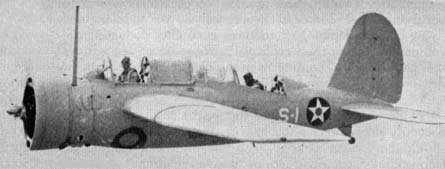
SBA SBN
Designed by Brewster as the SBA scout bomber, it was produced by the Naval Aircraft Factory as the SBN. 30 examples were ordered, but with more advanced aircraft becoming available, most were used as trainers.
Brewster SBA/SBN
Type: carrier-based scout bomber/trainer
Crew: 2
Armament: one 0.30 inch machine gun in rear cockpit
up to 500 lbs. of bombs
Specifications:
Length: 27' 8" (8.43 m)
Height: 8' 7" (2.64 m)
Wingspan: 39' 0" (11.89 m)
Wing area: 259 sq. ft (24.06 sq. m)
Max Weight: 6759 lb (3066 kg) max at takeoff
Propulsion:
No. of Engines: 1
Powerplant: Wright XR-1820-22 Cyclone radial
Horsepower: 950 hp
Performance:
Range: 1015 miles (1633 km)
Max Speed: 254 mph ( 409 km/h)
Ceiling: 28,300 ft (8625 m)
Brewster SB2A Buccaneer
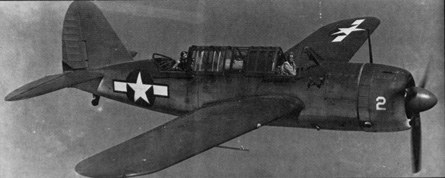
Having just completed the design of the SBA scout-bomber, Brewster set about to produce a more effective aircraft with heavier armament, increased bomb load and higher performance. Unfortunately, performance was far below that anticipated, and the larger, much heavier aircraft lacked maneuverability. The British were supplied SB2As under lend-lease (designated "Bermudas" by the British), but they also found them completely unsuitable for combat operations. As a result, SB2As only saw second-line service as target towing and training aircraft.
Type: naval scout bomber
Crew: 2: Pilot, gunner
Armament: two .50 cal machine guns in fuselage
two .30 cal machine guns in wing
two .30 cal machine guns in rear cockpit
up to 1,000 lb of bombs
Specifications:
Length: 39' 2" (11.94 m)
Height: 15' 5" (4.70 m)
Wingspan: 47' 0" (14.33 m)
Wing area: 379 sq. ft (35.21 sq. m)
Empty Weight: 9924 lb (4501 kg)
Max Weight: 14,289 lb (6481 kg) max at takeoff
Propulsion:
No. of Engines: 1
Powerplant: Wright R-2600-8 Cyclone radial
Horsepower: 1200 hp
Performance:
Range: 1675 miles (2696 km) without bombload
Cruise Speed: 161 mph ( 259 km/h)
Max Speed: 274 mph ( 441 km/h) at 12000 ft
Ceiling: 24,900 ft (7590 m)
Vought SB2U Vindicator
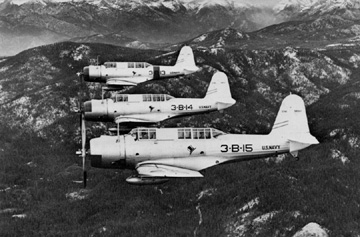
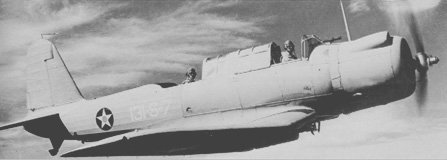
Nearly obsolete at the beginning of World War II, the Vindicator was known more often as the "Vibrator" due to the noise and vibrations that one endured while flying in it. While it was used by the Marines in the battle of Midway, it was soon retired from front-line service because it was too vulnerable to Japanese aircraft such as the Zero.
Type: Scout Bomber
Crew: 2, Pilot and observer
Armament: one .50 cal machine gun firing forward,
one .30 cal machine gun in rear cockpit,
up to 1000 lbs. of bombs
Specifications:
Length: 34' (10.36 m)
Height: 10' 3" (3.12 m)
Wingspan: 42' (12.80 m)
Wing area: 305 sq. ft (28.33 sq. m)
Empty Weight: 5634 lbs (2555 kg)
Gross Weight: 9421 lbs (4272 kg)
Propulsion
No. of Engines: 1
Powerplant: Pratt & Whitney R-1535-02
Horsepower: 825 each
Performance
Range: 1120 miles (1803 km)
Cruise Speed: 152 mph (244 km/hr)
Max Speed: 243 mph (391 km/hr)
Climb: 1070 ft/min (326.12 m/min)
Ceiling: 23600 ft (7192.90 m)
Curtiss SBC Helldiver
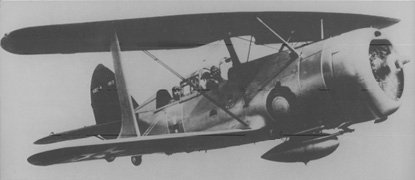
The SBC Helldiver was the last combat biplane to be produced by the United States. This dive bomber entered service in 1937 and still flew with front-line units at the beginning of the war, although it was withdrawn soon afterwards. It was replaced by the Douglas SBD Dauntless, which in turn was replaced by another (later) Curtiss Helldiver.
Type: two-seat carrier-based scout bomber
Crew: 2: Pilot, Gunner
Armament: one .30 cal forward firing machine gun
one .30 cal machine gun in rear cockpit
one 500 lb. or 1000 lb. bomb
Specifications:
Length: 28' 4" (8.64 m)
Height: 12' 7" (3.84 m)
Wingspan: 34' 0" (10.36 m)
Wing area: 317 sq. ft (29.45 sq. m)
Empty Weight: 4841 lb (2196 kg)
Max Weight: 7632 lb (3462 kg) max at takeoff
Propulsion:
No. of Engines: 1
Powerplant: Wright R-1820-34 Cyclone radial
Horsepower: 950 hp
Performance:
Range: 590 miles (950 km) w/ 500 lb. bomb load
Cruise Speed: 127 mph ( 204 km/h)
Max Speed: 237 mph ( 381 km/h) at 15,200 ft
Ceiling: 27,300 ft (8320 m)
Curtiss SB2C Helldiver
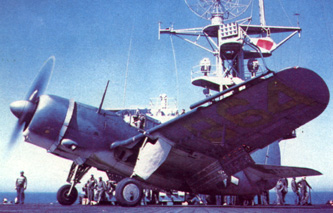
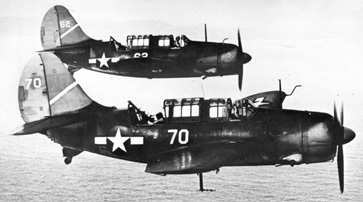
Like its predecessor (the SBC biplane dive bomber by Curtiss), the SB2C is also called the Helldiver. The SB2C is the better known Helldiver of the two, mainly due to its combat use in the last half of WWII. The SB2C is also known by the nickname "Big Tailed Beast" and a few other names by those who flew it. The Helldiver replaced the aging Douglas Dauntless as the dive bomber of the US Navy, though initial teething problems left many wishing they had kept their dependable Dauntlesses. By the war's end, however, the SB2C was proving its worth. The Helldiver was also adopted by the Army under the designation A-25.
Type: two-seat carrier-based scout bomber
Crew: 2: Pilot, Gunner
Armament: two 20mm cannon in wings,
two .30 cal machine guns in rear cockpit
Specifications:
Length: 36' 8: (10.97 m)
Height: 13' 2" (4.01 m
Wignspan: 49' 9" (15.16 m)
Gross Weight: 16616 lb
Propulsion:
No. of Engines: 1
Powerplant: Wright R-2600-20
Horsepower: 1900 hp
Performance:
Range: 1165 miles (1876 km)
Cruise Speed: 158 mph (254 km/h)
Max Speed: 295 mph (475 km/h)
Ceiling: 29100 ft (8869 m)
Douglas SBD Dauntless
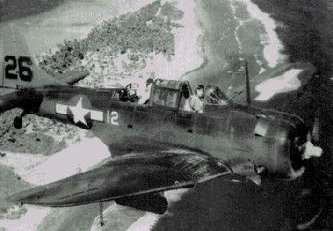
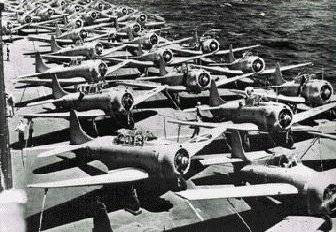
The Dauntless was the most famous of the dive bombers used by the US Navy, and it made history in the destruction of four Japanese carriers at the battle of Midway. It also served with distinction at Coral Sea and in the Solomons campaign, and continued to be used until late 1944. It had slotted dive brakes that could be opened in the trailing edge of the wings to slow down its rate of descent when making near vertical dives on the target. The Army Air Corps also used a version, known as the A-24.
Type: Dive Bomber / Scout bomber
Crew: 2, Pilot and observer/rear gunner
Armament: two .50 cal machine guns firing forward,
two .30 cal machine guns in rear cockpit,
up to 1600 lbs. of bombs centerline, 650 lbs. more under wings
Specifications:
Length: 32' 8" (9.96 m)
Height: 13' 7" (4.14 m)
Wingspan: 41' 6" (12.66 m)
Wing area: 325 sq. ft (30 sq. m)
Empty Weight: 6181 lb (2804 kg)
Gross Weight: 10179 lb (4625 kg)
Max Weight: 10200 lb (4627 kg)
Propulsion:
No. of Engines: 1
Powerplant: Wright R-1820-60
Horsepower: 1200 hp
Performance:
Range: 950 miles (1530 km)
Cruise Speed: 173 mph (278 km/h)
Max Speed: 250 mph (402 km/h)
Climb: 1700 ft/min (518 m/min)
Ceiling: 26000 ft (7780 m)
Douglas TBD Devastator
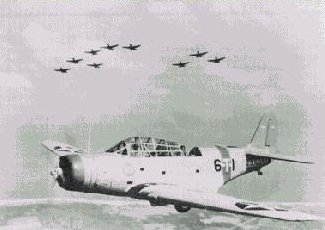
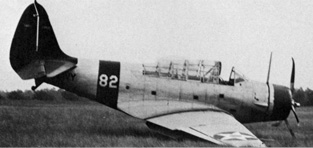
When it was delivered to the US Navy in 1937, the Devastator was the most advanced torpedo bomber in the world. A mere four years later, however, the TBD was practically obsolete, a fact which became painfully obvious when all 35 Devastators sent against the Japanese at the battle of Midway were shot down without hitting their targets. Luckily its replacement (the Grumman TBF Avenger) was coming on line at that time, and soon all Devastators were withdrawn from front-line service. 130 built.
Type: Torpedo bomber
Crew: 2, Pilot and observer/rear gunner
Armament: one .30 cal machine gun firing forward,
one .30 cal machine gun in rear cockpit,
one torpedo, or one 1000 lb. bomb
Specifications:
Length: 35' 0" (10.67 m)
Height: 15' 1" (4.60 m)
Wingspan: 50' 0" (15.24 m)
Wing area: 422 sq. ft (39.2 sq. m)
Empty Weight: 5600 lbs (2539 kg)
Gross Weight: 10194 lbs (4623 kg)
Propulsion:
No. of Engines: 1
Powerplant: Pratt & Whitney R-1830-64
Horsepower: 900 hp
Performance:
Range: 716 miles (1152 km)
Cruise Speed: 128 mph (206 km/hr)
Max Speed: 206 mph (331 km/hr)
Climb: 720 ft/min (219.45 m/min)
Ceiling: 19500 ft (5943.3 m)
Grumman TBF/TBM Avenger
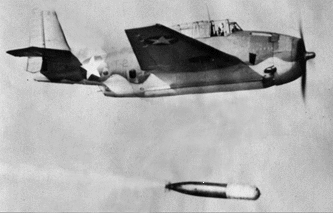
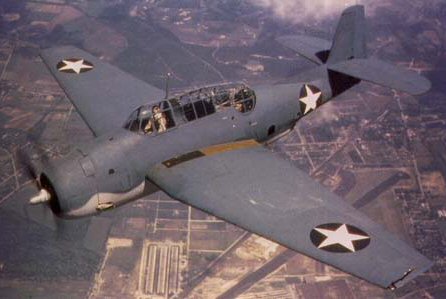
The Avenger replaced the TBD Devastator as the torpedo plane used by the U.S. Navy. It saw its first combat at the battle of Midway, but it wasn't until later battles that it made its mark in history. It could attack with either a torpedo or standard bombs. Distinguishing characteristics include a long internal torpedo bay and a revolving turret for a rear-facing gunner. Many Avengers were manufactured by General Motors Eastern Aircraft Division under the designation TBM Avenger.
Type: Torpedo Bomber
Crew: 3 (pilot, bomb-aimer, radio operator/gunner)
Armament: two wing-mounted .50 cal machine guns
one .50 cal machine gun in dorsal turret
one .30 cal machine gun in ventral position
up to 2000 lbs. of weapons (bombs/torpedo)
Specifications:
Length: 40' 11" (12.47 m)
Height: 16' 5" (5.00 m)
Wignspan: 54' 2" (16.51 m)
Wingarea: 490.02 sq. ft (45.52 sq. m)
Empty Weight: 10545 lb (4782 kg)
Gross Weight: 17893 lb (8115 kg)
Max Weight: 17895 lb (8115 kg)
Propulsion:
No. of Engines: 1
Powerplant: Wright R-2600-20
Horsepower: 1900 hp
Performance:
Range: 1010 miles (1626 km)
Cruise Speed: 147 mph ( 236 km/h)
Max Speed: 276 mph ( 444 km/h)
Climb: 2060 ft/min ( 627.86 m/min)
Ceiling: 30100 ft (9174.00M)
Vought TBU / Consolidated TBY
Sea Wolf
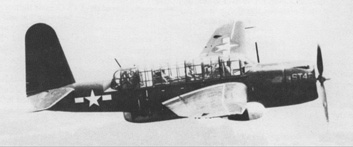
Competing against the Grumman Corp. to provide a replacement for the Douglas TBD Devastator torpedo plane for the U.S. Navy, the Vought Sea Wolf was proved to be considerably superior to the TBF Avenger. Like the Avenger, it had a long internal torpedo bay and a revolving dorsal turret for a rear-facing gunner. Despite a U.S. Navy decision to procure the type without delay, Vought was unable to produce enough aircraft from its limited capacity. This led to a contract being awarded to Consolidated Aircraft for 1,100 TBY-2 Sea Wolfs, though VJ-Day cancellations resulted in only 180 examples being made. None of these saw operational use, however.
Type: Torpedo Bomber
Crew: 3 (pilot, bomb-aimer, radio operator/gunner)
Armament: three forward firing .50 cal machine guns
one .50 cal machine gun in dorsal turret
one .30 cal machine gun in ventral position
one torpedo in internal bay
Specifications:
Length: 39' 2.5" (11.9512.47 m)
Height: 15' 6" (4.72 m)
Wignspan: 56' 11" (17.35 m)
Takeoff Weight: 18,488 lb (8386 kg) maximum
Propulsion:
No. of Engines: 1
Powerplant: Pratt & Whitney R-2800-20 Double Wasp
Horsepower: 2000 hp
Performance:
Range: 1500 miles (2414 km)
Max Speed: 306 mph ( 492 km/h)
Ceiling: 27200 ft (8290 M)